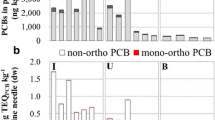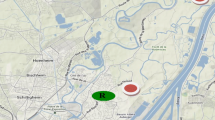Abstract
Commonly available Korean pine (Pinus korariensis) and Mongolian oak (Quercus mongolica) were used as biomonitors to find out the background air concentrations of polychlorinated biphenyls (PCBs) and polybrominated diphenyl ethers (PBDEs) in Seoul metropolitan area in Korea. Needles and leaves were collected in February, April, August, October and December in the year 2002 from the city center (Namsan) and outskirts (Kwanaksan) of Seoul. The annual average concentrations (dry weight) of PCBs and PBDEs were higher in the city center than outskirts and in Mongolian oak than pine leaves. Those values in Mongolian oak were: Namsan PCBs 7.58±6.73, PBDEs 1.80±2.07: Kwanaksan PCBs 6.77±4.08, PBDEs 0.70±0.55. The corresponding values in pine needles were: 2.68±0.92, 0.70±0.41 ∶ 2.3±1.61, 0.22±0.18. Overall 24 PCBs, including dioxin-like coplanar PCBs and 9 PBDEs congeners were detected in the samples. Concentrations were usually high in winter than summer. Pine needles enriched mostly lower chlorinated PCBs and Mongolian leaves the higher chlorinated congeners. The most dominant PBDEs determined in both species were BDE-99 and −47. Correlation of PCB concentrations with gas partition coefficient (Kp) and octanol water partitioning coefficient revealed that the uptake mechanism in pine needle was governed by absorption from vapor phase and aerosol particle adsorption in Mongolian leaves. Correlation between PCBs and PBDEs suggests different point sources. TEQs were derived for toxic PCBs in leaf samples as an indicator of possible air-borne health risk.
Similar content being viewed by others
References
Cheng, H., Zhang, G., Xunyi, J. J., Li, X. & Li, J. Organochlorine pesticides, polybrominated biphenyl ethers and lead isotopes during the spring time at the Waliguan Baseline Observatory, northwest China: Implication for long-range atmospheric transport.Atmos Environ 41, 4734–4747 (2007).
Dams, R. Nuclear activation techniques for the determination of trace elements in atmospheric aerosols, particulates and sludge samples (Technical report).Pure App Chem 64, 991–1014 (1992).
Simonich, S. L. & Hites, R. A. Global distribution of persistent organochlorine compounds.Science 269, 1851–1854 (1995).
Capannesi, E., Caroli, S. & Rosada, A. Evergreen oak leaves as natural monitor in environmental pollution.J Radioanal Nucl Chem 123, 713–729 (1988).
5. de Souza Pereira, M.et al. Persistent organic pollutants in atmospheric deposition and biomonitoring with Tillandsia Usneoides (L.) in an industrialized area in Rio de Janeiro state, south east Brazil — Part I: PCDD and PCDF.Chemosphere 67, 1728–1735 (2007).
Hendersona, A. Literature on air pollution and lichens XLII.The Lichenologist 27, 395–404 (1995).
Kim, G.et al. Evidence for anthropogenic210Po in the urban atmosphere of Seoul, Korea.Environ Sci Technol 39, 1519–1522 (2005).
Waldum, A. J. & Engelsen, C. J. PCB-holdige materialer i puss og betong. En historisk oppsummering og kjemisk analyse av 10 utvalgte malingsprøver. 2003 (translated title: A historical summary and chemical analysis of 10 paint samples).Norges byggforskningsinstitutt report,O-10786 (2002).
Moon, H. B., Kannan, K., Lee, S. J. & Choi, M. Atmospheric deposition of polybrominated diphenyl ethers (PBDEs) in coastal areas in Korea.Chemosphere 66, 585–593 (2007).
Yeo, H. G.et al. Concentration characteristics of atmospheric PCBs for urban and rural area, Korea.Science of the Total Environment 324, 261–270 (2004).
Kauneliené, V., Cicènaitée, A., Jegorova, I., Žaliauskiené A. & Bergqvist, P. Tentative air concentrations of PAHs and PCBs in urban area of Lithuania.Environ Research Engine Manage 2, 33–39 (2004).
Jaward, F. M.et al. Passive air sampling of PCBs, PBDEs, and organochlorine pesticides across Europe.Environ Sci Technol 38, 34–41 (2004).
Hong, S. H.et al. Assessment of sediment contamination by persistent organic pollutants in Gyeonggi Bay, Korea.Tox Environ Health Sci 1, 56–63 (2009).
14. Di Guardo, A.et al. Conifer needles as passive biomonitors of the spatial and temporal distribution of DDT from a point source.Chemosphere 52, 789–797 (2003).
Kylin, H. Airborne lipophilic pollutants in pine needles.Environ Sci Pollut Res 3, 218–223 (1996).
Moussiopoulos, N. inStudying atmospheric pollution in urban areas-overview of subproject SATURN. (eds Midgley, P. M. & Reuter, M.) 227–249 (Margraf Verlag, Weikersheim, 2003).
Romanic, S. H. & Krauthacker, B. Are pine needles bioindicators of air pollution? Comparison of organochlorine compound levels in pine needles and ambient air.Arh Hig Rada Toksikol 58, 195–199 (2007).
Kannan, N. Non-ortho and mono-ortho substituted PCBs inThe Handbook of Environmental Chemistry. (ed Paasivirta, J.) 127–156 (Springer-Verlag, Berlin, 2000).
Kannan, N., Hong, S. H. & Oh, J. R. Quantitation of co-planar PCBs in 20 different commercial PCB mixtures using multi dimensional gas chromatography and electron donor-acceptor high-performance liquid chromatography.Bull Environ Contam Toxicol 75, 897–902 (2005).
Kannan, N., Petrick, G., Bruhn, R. & Schulz-Bull, D. E. Structure-dependent separation method for non-ortho CBs with matrix-integrated quality control: A multidimensional analytical approach.Chemosphere 37, 2385–2393 (1998).
Kannan, N.et al. PYE [2-(1-pyrenyl)ethyldimethysilylated silica] column HPLC and HR-GC-(micro) ECD in the accurate determination of toxic co-planar PCBs and Polybrominated diphenyl ethers (PBDEs-Bull Korean Chem Soc 26, 529–536 (2005a).
Öberg, T., Warman, K. & Bergström, J. Distribution of toxic coplanar PCBs and PCDD/PCDFs in pine needles from the Swedish environment-evaluation of data and source identification.Organohalogen Compounds 1, 449–452 (1990).
van den Berg, M.et al. The 2005 World Health Organization Re-evaluation of Human and Mammalian Toxic Equivalency Factors for Dioxins and Dioxin-like Compounds.ToxSci Advance Access http://www.who. int/ipcs/assessment/tef_update/en/ (2006).
USEPA. Basic concepts in environmental sciences. Module 2: Characteristics of gases. http://www.epa. gov/ (2009).
Okazawa, T.et al. Congener-specific data of PBDEs in pine needles.Organohalogen Compounds 66, 3774–3778 (2004).
Harner, T., Shoeib, M., Diamond, M., Ikonomou, M. & Stern, G. Passive sampler derived air concentrations Assessment of Seoul Atmosphere through Biomonitoring 115 of PBDEs along an urban-rural transect: Spatial and temporal trends.Chemosphere 64, 262–267 (2006).
Boethling, R. S. & Mackay, D. inProperty Estimation Methods for Chemicals (Lewis Publishers, Boca Raton, 2000).
Finizio, A., Mackay, D., Bidleman, T. & Harner, T. Octanol-air partition coefficient as a predictor of partitioning of semi-volatile organic chemicals to aerosols.Atmospheric Environment 31, 2289–2296 (1997).
Reischl, A., Reissinger, M., Thoma, H. & Hutzinger, O. Accumulation of organic air constituents by plant surface: Part IV.Chemosphere 18, 561–568 (1989).
Strachan, W. M. J., Eriksson, G., Kylin, H. & Jensen, S. Organochlorine compounds in pine needles: Methods and trends.Environ Toxicol Chem 13, 443–451 (1994).
Jingwen, C.et al. Quantitative structure-property relationships for octanol-air partition coefficients of polychlorinated biphenyls.Chemosphere 48, 535–544 (2002).
Wania, F. & McLachlan, M. S. Estimating the influence of forests on the overall fate of semivolatile organic compounds using a multimedia fate model.Environ Sci Technol 35, 582–590 (2001).
Hong, S. H., Yim, U. H., Shim, W. J., Oh, J. R. & Lee, I. S. Horizontal and vertical distribution of PCBs and chlorinated pesticides in sediments from Masan Bay, Korea.Mar Pollut Bull 46, 244–253 (2003).
Author information
Authors and Affiliations
Corresponding author
Rights and permissions
About this article
Cite this article
Kannan, N., Hong, S.H., Yim, U.H. et al. Biomonitoring background levels of PCBs and PBDEs in Seoul metropolitan atmosphere for possible health effects. Toxicol. Environ. Health. Sci. 1, 109–116 (2009). https://doi.org/10.1007/BF03216471
Accepted:
Issue Date:
DOI: https://doi.org/10.1007/BF03216471




